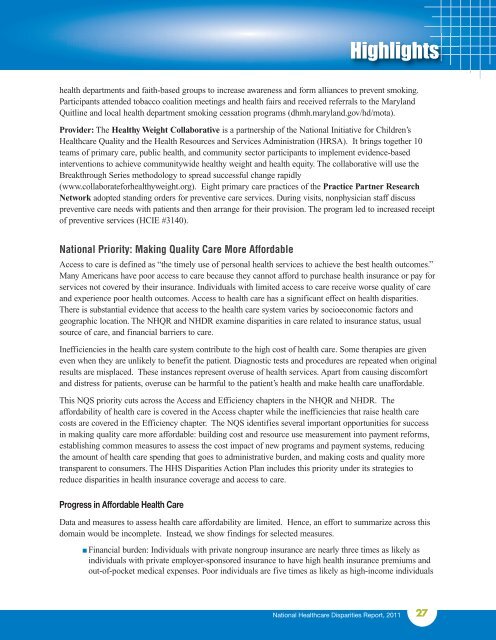National Healthcare Disparities Report - LDI Health Economist
National Healthcare Disparities Report - LDI Health Economist
National Healthcare Disparities Report - LDI Health Economist
Create successful ePaper yourself
Turn your PDF publications into a flip-book with our unique Google optimized e-Paper software.
Highlights<br />
health departments and faith-based groups to increase awareness and form alliances to prevent smoking.<br />
Participants attended tobacco coalition meetings and health fairs and received referrals to the Maryland<br />
Quitline and local health department smoking cessation programs (dhmh.maryland.gov/hd/mota).<br />
Provider: The <strong>Health</strong>y Weight Collaborative is a partnership of the <strong>National</strong> Initiative for Children’s<br />
<strong><strong>Health</strong>care</strong> Quality and the <strong>Health</strong> Resources and Services Administration (HRSA). It brings together 10<br />
teams of primary care, public health, and community sector participants to implement evidence-based<br />
interventions to achieve communitywide healthy weight and health equity. The collaborative will use the<br />
Breakthrough Series methodology to spread successful change rapidly<br />
(www.collaborateforhealthyweight.org). Eight primary care practices of the Practice Partner Research<br />
Network adopted standing orders for preventive care services. During visits, nonphysician staff discuss<br />
preventive care needs with patients and then arrange for their provision. The program led to increased receipt<br />
of preventive services (HCIE #3140).<br />
<strong>National</strong> Priority: Making Quality Care More Affordable<br />
Access to care is defined as “the timely use of personal health services to achieve the best health outcomes.”<br />
Many Americans have poor access to care because they cannot afford to purchase health insurance or pay for<br />
services not covered by their insurance. Individuals with limited access to care receive worse quality of care<br />
and experience poor health outcomes. Access to health care has a significant effect on health disparities.<br />
There is substantial evidence that access to the health care system varies by socioeconomic factors and<br />
geographic location. The NHQR and NHDR examine disparities in care related to insurance status, usual<br />
source of care, and financial barriers to care.<br />
Inefficiencies in the health care system contribute to the high cost of health care. Some therapies are given<br />
even when they are unlikely to benefit the patient. Diagnostic tests and procedures are repeated when original<br />
results are misplaced. These instances represent overuse of health services. Apart from causing discomfort<br />
and distress for patients, overuse can be harmful to the patient’s health and make health care unaffordable.<br />
This NQS priority cuts across the Access and Efficiency chapters in the NHQR and NHDR. The<br />
affordability of health care is covered in the Access chapter while the inefficiencies that raise health care<br />
costs are covered in the Efficiency chapter. The NQS identifies several important opportunities for success<br />
in making quality care more affordable: building cost and resource use measurement into payment reforms,<br />
establishing common measures to assess the cost impact of new programs and payment systems, reducing<br />
the amount of health care spending that goes to administrative burden, and making costs and quality more<br />
transparent to consumers. The HHS <strong>Disparities</strong> Action Plan includes this priority under its strategies to<br />
reduce disparities in health insurance coverage and access to care.<br />
Progress in Affordable <strong>Health</strong> Care<br />
Data and measures to assess health care affordability are limited. Hence, an effort to summarize across this<br />
domain would be incomplete. Instead, we show findings for selected measures.<br />
n Financial burden: Individuals with private nongroup insurance are nearly three times as likely as<br />
individuals with private employer-sponsored insurance to have high health insurance premiums and<br />
out-of-pocket medical expenses. Poor individuals are five times as likely as high-income individuals<br />
<strong>National</strong> <strong><strong>Health</strong>care</strong> <strong>Disparities</strong> <strong>Report</strong>, 2011<br />
27

















